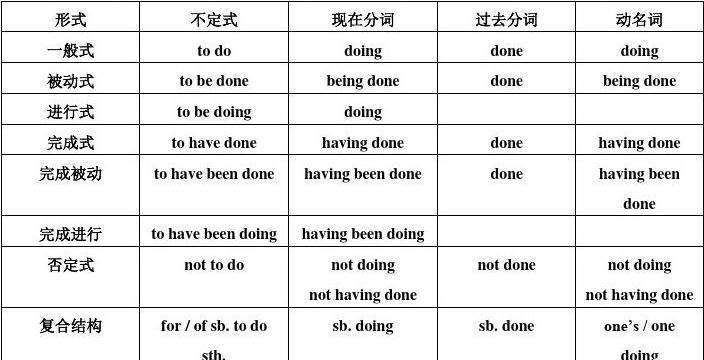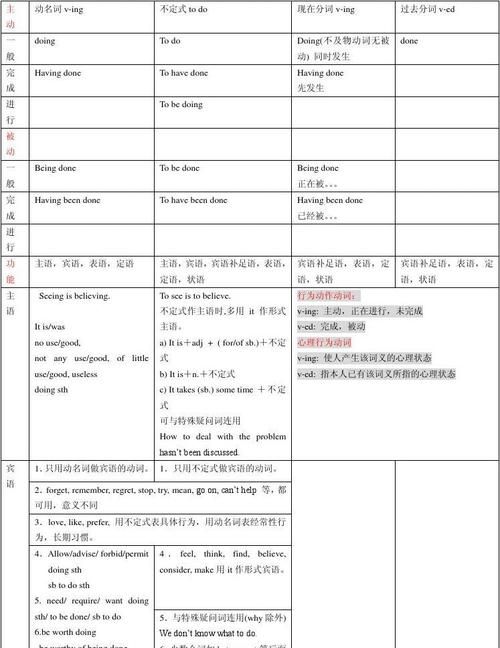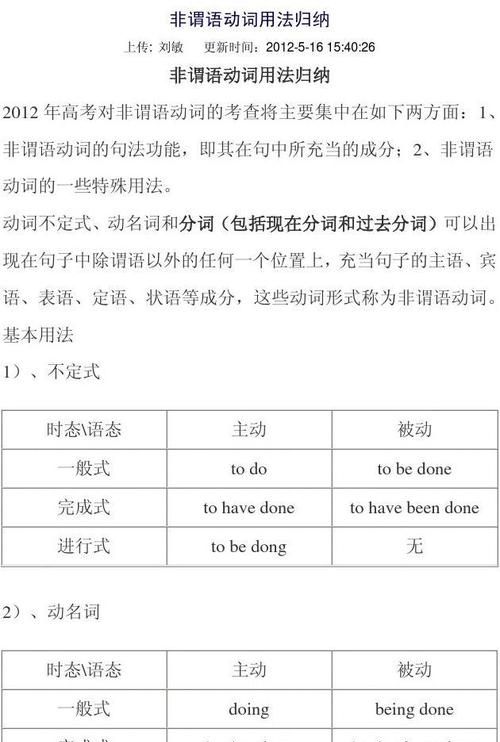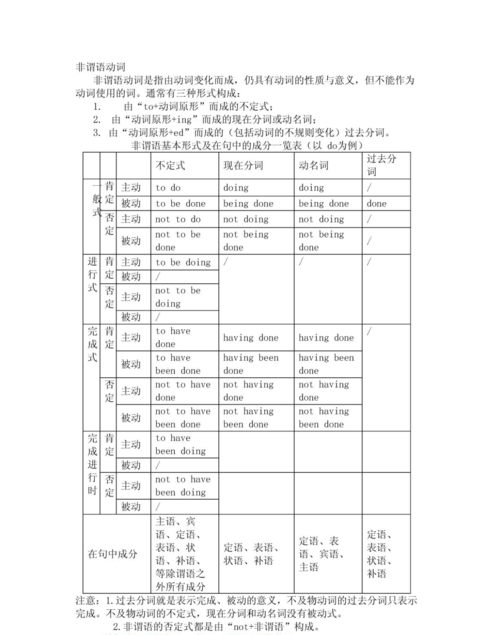本文目录
定语从句和非谓语动词的转换
定语从句和非谓语动词解析:
熟悉非谓语动词的同学们应该都知道,非谓语动词包括to do, doing和done,这三类动词的特别之处就在于它们可以在句子里面充当除谓语以外的任何成分,其中一个非常重要的用法就是位于名词后作为名词的后置定语,比如:
The semiarid lands bordering the deserts exist in a delicate ecological balance and are limited in their potential to adjust to increased environmental pressures.
以上例句里的非谓语动词的短语“bordering the deserts”就是用作定语来修饰前面的名词短语“the semiarid lands”。
很多同学很熟悉定语从句,而对非谓语动词的用法总是有种望而却步的感觉。
但是细心的同学肯定会发现,其实在语法家族里,当将非谓语动词用作后置定语的时候,它与定语从句的.用法是一样的,两者是名副其实地长相不同,但却有血缘关系的“远房表亲”。比如,上面的例子我们就可以改写成定语从句:
The semiarid lands which border the deserts exist in a delicate ecological balance and are limited in their potential to adjust to increased environmental pressures.
再如以下带有非谓语动词短语的句子:
Theorist adopting the psychodynamic approach hold that inner conflicts are crucial for understand human behavior, including aggression.
我们可以改成定语从句:
Theorist who adopt the psychodynamic approach hold that inner conflicts are crucial for understand human behavior, including aggression.
又如,以下的两个句子的意思是相同的:
1.What audience came to see was the magic made possible by trick photography and manipulation of the cinema.
2.What audience came to see was the magic that was made possible by trick photography and manipulation of the cinema.
在很多情况下,学生更容易理解定语从句。所以,下次在处理包含非谓语动词短语的长难句时,不妨将其改写成定语从句,方便我们理解长难句。
那么问题来了,定语从句和作定语的非谓语动词之前是否有某种特定的对应关系呢?答案是有的,关系如下:
Which be to do = to do(表主动/将来)
Which do... = doing...(表主动)
Which be done... = done...(表被动)
为方便大家记忆,哈耶普的老师为大家准备了一个“玫瑰凋谢理论”:
1.The roses to be planted in the garden are fading away.
2.Tho roses which are to be planted in the garden are fading away.
1.The roses growing in the garden are fading away.
2.The roses which grow in the garden are fading away
1.The roses planted in the garden are fading away.
2.The roses which are planted in the garden are fading away

关于动词的非谓语形式 现在分词 过去分词做后置定语的英语句子
1.非谓语形式:不定式做后置定语,表示将要做(还没有做)
I have something (to do this evening).
2.现在分词做定语时,位置不定,如果是一个现在分词,前置,如果是短语后置.表主动.
The boy (sitting by the window )is Tom.
3.过去分词作定语和现在分词相同,如果是一个过去分词,前置,如果是短语后置.表被动.
The boy (named Tom )was hurt in the car accident.

非谓语做后置定语英语例子
为您解答
因为句子前有序数词the first,语法规定序数词后面要加不定式to...做后置定语。
由序数词或形容词最高级修饰的名词常常用不定式作定语
例如
He was the first one to think of the idea.

高中英语:后置定语与非谓语有什么区别
简单概括:一个句子中,非谓语可以充当后置定语,但是后置定语不一定只能由非谓语充当。
此外,非谓语也可以充当其他句子成分。
具体说明:
(一)不同点:概念不同。
1. 非谓语是指非谓语动词,特点是可以在句子中充当除谓语以外的其他句子成分。非谓语动词有三种:不定式(to+动词原形 )、动名词(动词原形+-ing)、分词。分词分为现在分词和过去分词,前者的形式为动词原形+ing,如doing,washing,jumping,sitting,making等;后者的形式为动词原形+-ed,如washed,jumped等,或不规则变化,如done,sat,made等。
2. 定语是一种句子成分,后置定语则指放在它所修饰的词之后的句子成分。
(二)关系:非谓语动词中,只有不定式和分词可以在句子中充当后置定语。它们各自组成的短语也可以充当后置定语。
例:
(1) Do you have anything to send?你有什么要寄的东西吗?
句中to send是不定式,在句子中修饰anything,充当anything的后置定语。
(2)That girl sitting there is a good singer. 坐在那儿的那个姑娘是个好歌手。
句中sitting是现在分词,sitting there是分词短语,修饰girl,充当girl的后置定语。
(3)Everyone involved should stay here. 每个参与的人都应该待在这儿。
句中involved是过去分词,修饰everyone,充当everyone的后置定语。
(三)补充
除了非谓语动词之外,还有很多可以充当后置定语,比如副词、短语、形容词等。
例:(1)The people here are very friendly. 这里的人很友好。
副词here充当people的后置定语。
(2)He gave me a basket full of eggs. 他给了我一个装满鸡蛋的篮子。
短语full of eggs充当basket的后置定语。
(3)Let's go somewhere quiet. 咱们去个安静的地方吧。
形容词quiet充当somewhere的后置定语。
句子成分包括:主语、谓语、宾语、定语、状语、表语、补语、同位语等。
词类包括:名词、代词、动词、形容词、副词、数词、冠词、连词、介词。

以上就是关于非谓语动词作后置定语的例子,定语从句和非谓语动词的转换的全部内容,以及非谓语动词作后置定语的例子 的相关内容,希望能够帮到您。
